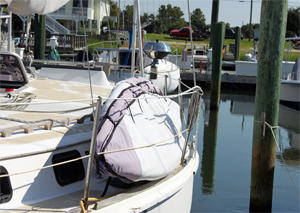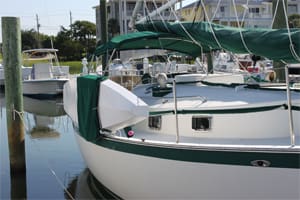Attaching gear to lifelines and stanchions is generally not wise and sometimes dangerous. This gear includes but is not limited to solar panels, jerry cans, kayaks and paddle/surfboards, bicycles, etc. This applies to boats that will go offshore but is also applicable for all boats that spend any time in open water and do more than daysailing hops in fine weather.
At the least problematic, but perhaps the most insidious, are your stanchions and lifelines. Stanchion deck fittings are typically not designed or installed to tolerate the rhythmic back-and-forth tugging and stresses of heavy jerry cans pulling on them with every wave, for example, or the rhythmic continuous pounding inflicted when sailing hard to wind. These repeated stresses can lead to leaks in the stanchion bases (if this occurs, look to whether there has been gear attached) or stress fractures (look at the welds down low). What’s more dangerous is if the leak does not become apparent below decks, since at least then there would be warning. Leaks into your deck core, however, may be hidden; this can be especially problematic if the core is balsa.
Pushpits are likely to be better attached to the deck, and often are constructed of tubing rather than wire. It seems reasonable to have a horseshoe and a Lifesling attached, or perhaps a well-designed and well-supported wind generator. But think of the forces accrued from a full enclosure whose support comes from the pushpit structure. Imagine further, the forces beating to wind in a swell or sideways wind coupled with big waves. These are unusual events, but they are far from unheard of and statistically likely with enough miles under your keel.
Danger to footing
Having gear on deck can also endanger your ability to work the boat, establish footing, or move around safely and easily. And your deck can become skating-rink-slippery if your jerry can ever leaks a bit of diesel through heat expansion in the sun or otherwise.
The more dramatic examples of the folly of having “stuff” attached to lifelines and stanchions occurs when your boat falls off a wave or gets slammed by the occasional rogue wave. These forces can be enormous and are hard to imagine ahead of time. But, for those who have never been in a sailboat that has fallen off of a wave or gotten slammed by big one, think: an enormous blow, one that takes your breath away and causes you to worry about your fillings. These events are no longer the rhythmic wave events that the ocean is always subjecting us to, but rather shock loads. And these shock loads increase impressively with the amount of surface area involved. Jerry cans, with their weight, are hard on stanchions/lifelines for the rhythmic loads induced but actually present a fairly small surface area.
Instead, it is the paddleboards and kayaks that really excel in presenting a large target for waves or the forces of water slamming into the boat when falling off a wave. Most susceptible to causing damage are solar panels, which are usually mounted high on the lifelines/stanchions and subsequently exert the most leverage on the lifeline/stanchion combination. No lifeline/stanchion system is designed for these kinds of forces, and few attachments to the deck will endure these forces. You should feel lucky if all that happens is a leak to the interior; far more problematic are the caulking/bedding failures that allow water intrusion into a core material. The worst case of this would be with balsa, which will wick the water quickly and profusely. This can go unnoticed for long periods, only becoming apparent once much damage has occurred.
The most dramatic and potentially damaging scenario is a knockdown or a rollover. A knockdown will likely not cause exterior damage to a well-arranged offshore boat. Add gear to the lifelines and stanchions, however, and you are looking at the possibility of significant damage. Bent stanchions are probably a given, but holes from stanchion bases that have been loosened or pulled out are possible and downflooding could occur.
 |
|
Gear on deck like this should be secured prior to going offshore. |
|
Wayne Canning |
Stresses in a rollover
Often, little on deck will survive a rollover. The forces are just too great. The greatest danger is to one’s life raft, and too many — perhaps even a majority — of the installations are far too flimsy. On-deck raft installations should be mounted with through-deck bolts and backing plates, not screwed to the deck. My raft is in a valise in a cockpit locker, protected from rollovers and the elements, and handy at the working end of the boat when needed — no need to go forward. I know of boats surviving a rollover only to find everything gone, including the wooden grab rails that had been used to tie down gear, leaving only the bolts protruding.
The damage to the boat is what was focused on above, but in the boisterous conditions where the aforementioned events often occur, danger to the crew is a very real and scary possibility. When things are tumultuous, one wants to hunker down and not worry about the boat.
Lifelines, and the stanchions that support them, are designed for crew safety — not as convenient tie-off points. If in doubt, please check with naval architects and/or boatbuilders.
Bottom line, I consider gear stored attached to lifelines to be a safety issue to the boat as well as to the crew. Many with gear on deck will go years without mishap. But, like so many decisions regarding safety on the boat, it is best to plan for a scenario that keeps you and your vessel safe for when — if you put enough miles under your keel — the statistically inevitable happens. I would suggest rethinking all gear attached to lifelines and stanchions (or stern pushpits and handrails) so as to free these areas from potential damage to the boat and for ensuring safe operation.
Dick Stevenson and his wife, Ginger, voyage aboard their Valiant 42, Alchemy.

